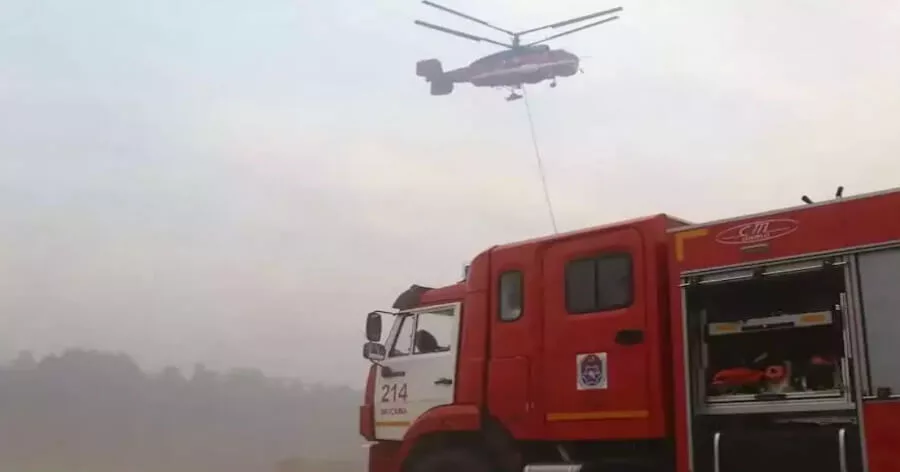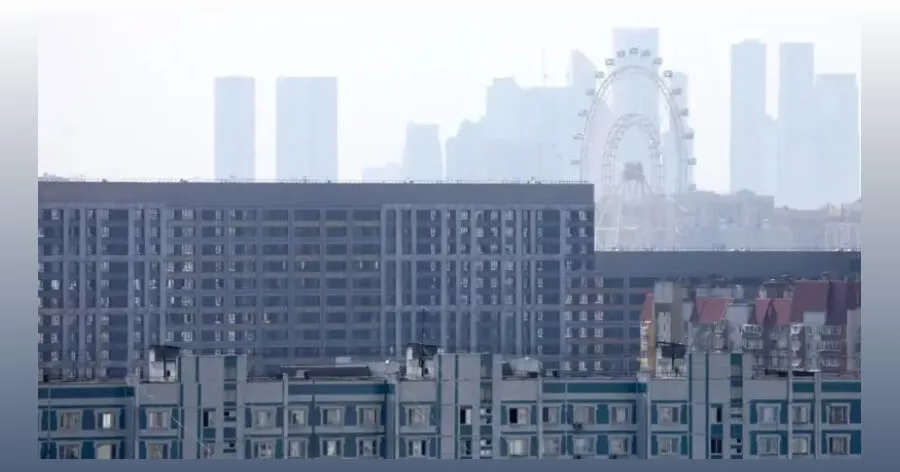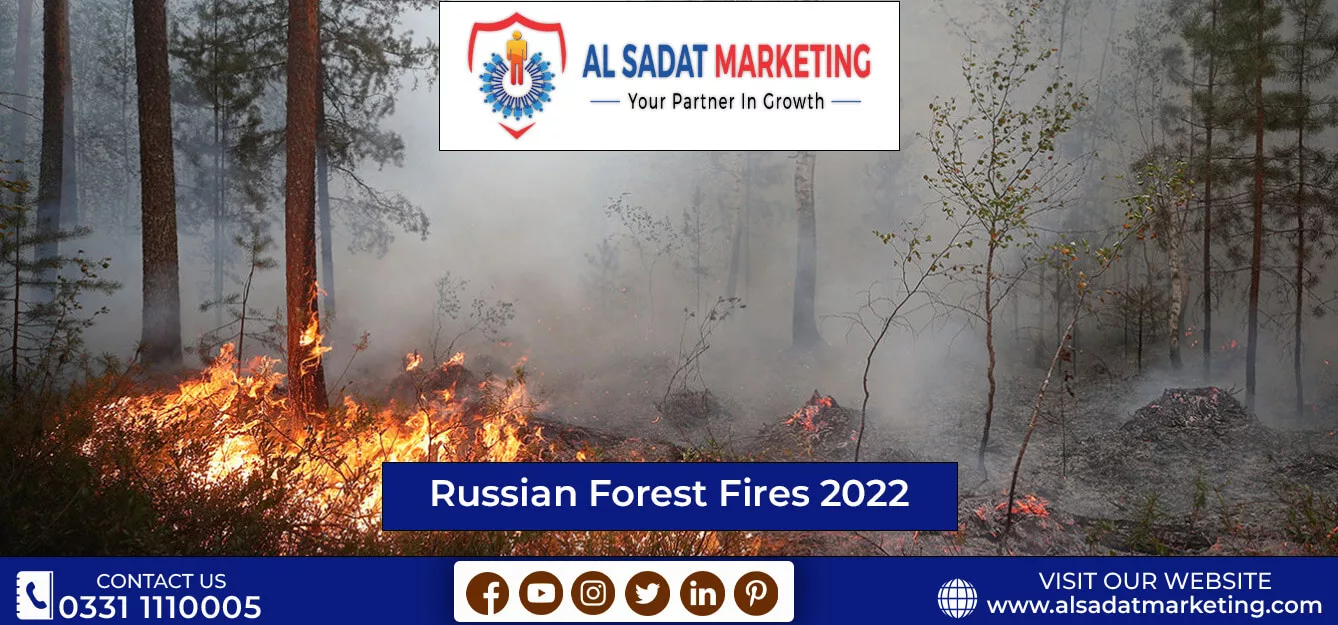Forest Fire Smoke Drifts Into Russian Capital Amid Heatwave

Each year, thousands of wildfires devour large areas of Russia, burning forests and obscuring areas in foul smoke.
This summer’s record-breaking heat has caused unusually large flames in northeastern Siberia. The huge country’s many other regions have also dealt with wildfires.
Read More:
On August 18, Russian firefighters battled fires raging across forests southeast of Moscow as citizens of the capital grumbled about the oppressive heat and the strong smoke smell. This week, smoke began to drift into Moscow from the Ryazan region, about 200 kilometers distant, where authorities were rushing personnel to put out the flames.
Acting governor of the area Pavel Malkov reported that more than 300 firemen were on the ground battling the fires and that helicopters had been brought in to help.
Even though the smell of smoke in Moscow had significantly subsided by afternoon, Mr. Malkov expressed concern that the strong winds that had been blowing smoke into other areas might continue.
Read More:
Residents of the capital city complained on Monday about a strong smoke odour permeating the air as forest fires raging south of Moscow grew in intensity. On Thursday, as inhabitants of the city lamented the oppressive heat and strong smoke odour, Russian firefighters battled fires raging across forests southeast of Moscow.
Malkov expressed his concern that strong winds could continue to spread smoke into other areas, despite the fact that the smell of smoke in Moscow had notably subsided later in the day.

Moscow, where an orange weather warning is in effect because of the heat, is projected to have temperatures as high as 33 degrees Celsius (91.4 degrees Fahrenheit) the next week. When a large forest fire blanketed the city in a thick layer of smog in 2010, Moscow registered its highest temperature, 38.2 degrees.
Authorities in Kaliningrad, a Russian exclave on the Baltic coast sandwiched between Poland and Lithuania, have also reported grass fires due to the unusually hot weather.
Read More:
Due to the harsher weather brought on by climate change, wildfires have grown more severe in Russia in recent years.
Environmentalists worry that fires and extreme heat could thaw the peatlands and permafrost in Siberia, releasing carbon that has been trapped in the frozen tundra for a long time.
The Federal Forestry Agency (Rosleskhoz) criticized Ryazan region officials for failing to contain the fires, and authorities in the Russian capital encouraged citizens to wear face masks to protect themselves from the pollution.
Read More:
The Federal Forestry Agency (Rosleskhoz) criticized Ryazan region officials for failing to contain the fires, and authorities in the Russian capital encouraged citizens to wear face masks to protect themselves from the pollution.
History of Fires in Russia
According to Greenpeace, Russia has lost a record number of acres of forest to fire this year compared to the previous 20 years of reliable data.
According to a tweet from the environmental organization’s Moscow office, fires have devastated 18.13 million hectares (45 million acres) of Russian forestry so far this year, breaking the previous record of 18.1 million set in 2012 and using the most recent satellite monitoring data. Only in 2001 did Russia start utilizing satellites to precisely track fires.

Climate Change and Forest Fires in Russia
Russia has recently seen extreme temperatures that many scientists believe to be a direct outcome of climate change. Authorities claim that more than 17 million hectares (42 million acres) of land in Russia were burned in wildfires last year as a result of the scorching weather and disregard for fire safety regulations.
A 2007 move to dissolve a federal aviation network tasked with detecting and putting out fires and handing over its assets to local authorities drew criticism from Russian specialists. The force rapidly declined as a result of the controversial move.
Read More:
Either natural or manmade reasons might cause a forest fire to start. Natural fire typically starts as a result of lightning or a sudden process of sawdust and leaf burning. A forest fire is started when lightning strikes the trees in the sky. A forest’s natural fire needs the fire triangle of heat, oxygen, and fuel to burn.
Fire typically spreads out in the direction where these three components are prevalent. In woods, there are three different kinds of natural fire that arise depending on the location. The most common type of fire is ground fire, which is typically fired on the ground and beneath the leaves. The forest’s surface, which is often at a height of up to 1.3 meters, is where the surface fire occurs.
Read More:
The most dangerous fires are crown fires, which spread to practically every corner of the jungle. Typically, they ignite on top of the tree, which burns the tree’s crowns. The fire spreads from one crown to another in this manner.

Record Heat
Russia has recently seen extreme temperatures that many scientists believe to be a direct outcome of climate change. Permafrost has melted as a result of the warm weather, which has also increased the number of fires.
The worst-affected region in Russia, the heat wave contributed to hundreds of fires that have charred more than 1.5 million hectares (3.7 million acres) of land thus far.
Failure to Monitor
Large portions of Russia are covered in forests, making it difficult to monitor fires and identify them immediately.
A federal network that monitored aircraft fires was abolished and its assets were given to local governments in 2007. The programme rapidly declined as a result of the harshly criticized adjustment.
Read More:
Later, the government undid the action and reinstated the federal agency in charge of aerial forest monitoring. Its limited resources make it difficult to explore the vast forests of Siberia and the Far East, nevertheless.
Neglecting Fire Safety Rules
While some wildfires are started by lightning, researchers believe that human activity is to blame for over 70% of them. This includes things like carelessly discarded cigarettes and abandoned campfires, among other things.
Authorities frequently carry out controlled burns, starting a fire to make room for new plants or remove fuel from unintentional wildfires. According to observers, such planned fires are frequently poorly controlled and occasionally start larger fires rather than putting them out.
Read More:
On agricultural grounds, farmers also burn grass and small trees using the same manner. These flames frequently get out of control.
Long Term Impacts of Forest Fires in Russia
Wildfires not only burn down forests but also kill wildlife and endanger public health due to air pollution.
Global warming and its potentially disastrous effects are also exacerbated by carbon emissions from fires and the clearing of forests, which are a significant supply of oxygen.
Read More:
According to Mark Parrington, a senior scientist at the European Center for Medium-Range Weather Forecasts, the fires in Siberia this year have already released more carbon dioxide into the atmosphere than some of the previous years’ flames.
He claimed that because peat has been accumulating carbon for tens of thousands of years, peat fires, which are frequent in Siberia and many other Russian regions, are especially destructive in terms of emissions.
You can also invest in other famous and most in demand housing societies, such as , Blue World City, Rudn Enclave, 7 Wonders City Peshawar, Taj Residencia, Kingdom Valley, New Metro City Gujar Khan, Forest Town Rawalpindi, University Town Rawalpindi, ICHS Town, Park View City Islamabad, Multi Gardens B17 Islamabad and Nova City Islamabad.
Al Sadat Marketing please contact 0331 1110005 or visit https://alsadatmarketing.com/
Few more real estate housing schemes which are trending now a days in Islamabad by including: Faisal Town Phase 2, Prism Town Gujar Khan, New City Paradise, Eighteen Islamabad, 7 Wonders City Islamabad, Capital Smart City, Silver City Islamabad, The Life Residencia, Faisal Town Islamabad, Islamabad Golf City, Islamabad Model Town and Marble Arch Enclave.
Al Sadat Marketing is an emerging Real Estate Agency headquartered in Islamabad, Pakistan. With over 10+ Years of experience, Al Sadat Marketing is providing its services and dealing all trending housing societies projects in different cities of Pakistan. Islamabad Projects, Rawalpindi Projects, Gujar Khan Projects, Burhan Projects, and Peshawar Projects etc.
Book Your Plot Now: +92 331 111 0005










